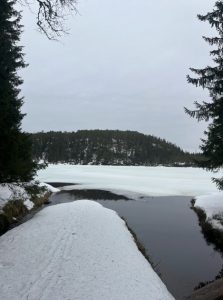Written by Kyle Johnston, John Arnell, Ada Vanderbilt, and Clare Hinnenkamp
A unique part of Norwegian culture largely absent from American culture is the concept of ‘friluftsliv,’ which translates to “outdoor living.” According to Statistisk sentralbyrå (Statistics Norway), in 2024, 96.5% of Norwegians regularly engaged in outdoor activities. These activities include everything from camping, fishing, berry picking, football, or even a short walk. In addition to enjoying outdoor activities, Norway has a free-roaming law allowing anyone the right to enjoy uncultivated land as long as they are considerate and respectful of nature. Norway facilitates these activities by providing spaces such as parks, sports complexes, and trails for public use. One example is the Bymarka nature reserve, located outside the city center of Trondheim, Norway’s third-largest city. Bymarka features over 200 kilometers of marked trails, offering almost endless hiking combinations.
In Bymarka, we tackled a six-kilometer trail called Baklidammen. Expecting light snow due to Trondheim’s relatively snow-free city center, we were unprepared for the knee-deep snow we encountered. The first half of the hike was challenging but rewarding, while the second half eased up, even revealing patches of dirt near the end. The highlight of the hike had to be the frozen lake we encountered around the halfway point. Staring across the frozen lake, we could see the beautiful snow-covered Norwegian forest.

The most treacherous part came at the finish: crossing an icy bridge. We clung to the railings, slipping and sliding, but ultimately made it back to the parking lot.

Interestingly, the Norwegian love of nature contrasts sharply with the country’s economic dependence on the oil industry. Since the 1960s, oil has significantly boosted Norway’s economy. As a result, not only has the quality of life greatly improved, but the government has established a national oil fund that will provide economic sustainability for generations.

However, this creates a contradiction: a nation deeply connected to its natural environment is also a major contributor to global carbon emissions. In 2023, Norwegian oil accounted for 2% of the world’s consumption (norskpetroleum). While this might seem small, it’s disproportionately high considering Norway’s population is less than 0.1% of the global total. The Norwegian government has recognized this contradiction and has begun rebranding itself from an “oil nation” to an “energy nation,” aiming to lead in clean energy development. According to the International Energy Agency, nearly 100% of Norway’s energy has come from renewable sources since 2022. This raises an important question: has Norway’s environmental progress offset the global impact of its oil industry? The answer is complex but reflects a broader effort to balance economic interests with environmental responsibility – a challenge for any nation striving to maintain its progressive image while meeting demands for a high standard of living.
All in all, we can only hope that the Norwegian government, and the US government as well, take responsibility for their environmental impact. If we can encourage these institutions to protect the world for future generations to come, then many can, like us, create memories in the beautiful outdoors – even if it consists of hiking through knee-high snow.